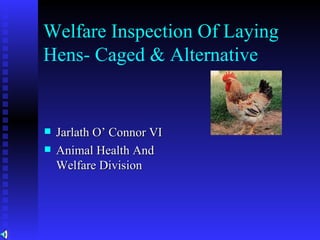D:\Animal Welfare\Powerpoints\Laying Hens\Sound\Completedmp3\Embedmp3
- 1. Welfare Inspection Of Laying Hens- Caged & Alternative Jarlath OŌĆÖ Connor VI Animal Health And Welfare Division
- 2. Systems
- 3. Where in Ireland? Main players Monaghan (37%) Cavan (14%) Rest (49%)
- 4. System Distribution? Main players Monaghan (66%) Cavan (1%)?
- 5. System Distribution? Main players Cavan (21%) Monaghan (20%) Rest (39%)
- 6. Alternative Systems S.I. 98/2002 All built/rebuilt/re-instated > 01/01/2002 For all > 01/01/2007 Facilities Nests One nest/ 7 hens Group nests- 1m 2 /120 hens
- 7. Alternative Systems Perches No sharp edges Not above litter 15 cm/hen 30 cm horiz. b/t perches 20 cm horiz. b/t perch and wall Levels No more than 4 levels < 54 cm headroom b/t levels Equal food and water access Droppings
- 8. Cage Systems Un-enriched (conventional) Cages From 01/01/2003 but not > 01/01/2012 hens may be kept in un-enriched cages 550 cm 2 /hen unrestricted Height >40 cm over 65% of cage or not < 35 cm at any point
- 9. Cage Systems Un-enriched (conventional) Cages From 01/01/2003 on: Floor support forward facing claws Slope of floor not > 14% or 8 degrees
- 10. Cage Systems CAGE SLOPE ┬Ā Cage depth (R) 50 cm Cage Height at back (P) 33 cm ┬Ā Cage height at front (S) 40 cm Floor slope (8 0 ) 7.9 0 (To Calculate: Tan x 0 = Q/R) (Therefore slope = x 0 = Tan -1 [(S-P) / R] ) P Q R S
- 11. Cage Systems Un-enriched (conventional) Cages From 01/01/2003 on: Cage fitted with suitable claw shortener
- 12. Cage Systems Enriched Cages From 01/01/2003 on: Total area of > 2000 cm 2 750 cm 2 /hen (at least 600 cm 2 usuable/ hen) Height > 20 cm at every point
- 13. Cage Systems Enriched Cages From 01/01/2003 on: Nest Litter 15 cm perch/hen/cage Claw shortener
- 14. Is ventilation satisfactory? Ventilation Keep temp., gas, dust and rel. humidity within healthy limits Maximum Vent. Rate Minimum Vent. Rate Air circulation Uniform Draught-free
- 15. Is ventilation satisfactory? Noxious gas build-up? Poor Ventilation Low ambient temp. Waste removal Wet litter Ammonia 5-15: Detectable by smell 10-20: Adverse effects on humans 25-50: Increased risk of resp. dis. 50+: Direct effect on layers R.R/eyes
- 16. Is ventilation satisfactory? What to look for? Thermometers Automated thermostats Air quality in shed Litter quality Faeces disposal
- 17. How long is rest period where artificial light is used? Lighting Darkness is deprivation S.I. 98/2002 Light sufficient to allow hens see eachother, be seen, to investigate and act normally 24 hr cycle with twilight and 8 hours uninterrupted darkness 35-65 lux Stage of cycle Lower tiers of cages Aggression Localised bunching Forced moulting
- 18. Litter adequacy/condition? S.I. 98/2002 Materials Health Mites Worms Behaviour Foraging Scratching Enriched cages? Adequate litter to allow pecking/scratching/hen
- 19. Equipment Maintenance Questions? How regularly is automated equipment checked? > once/day What alternatives are present should feeding or environmental equipment breakdown? Action plan Is there a functioning alarm system and generator? Must be present
- 20. Are the hens provided with adequate feed and water? Feeders S.I. 98/2002 Alternative Unrestricted access 10 cm linear feeder/hen 4 cm circular feeder/hen Un-enriched 10 cm feeder/hen Enriched 12 cm feeder/hen
- 21. Are the hens provided with adequate feed and water? Water supply S.I. 98/2002 Alternative Unrestricted access 2.5 cm/hen continous drinkers 1 cm/hen circular trough One nipple-drinker or cup/ 10 hens Plumbed drinking points ŌĆō 2 nipple-drinkers or cups within reach of each hen
- 22. Are the hens provided with adequate feed and water? Water supply S.I. 98/2002 Un-enriched Unrestricted access 10 cm linear trough/hen Plumbed drinking points ŌĆō 2 nipple-drinkers or cups/cage Enriched Unrestricted access Plumbed drinking points ŌĆō 2 nipple-drinkers or cups/hen/cage
- 23. The End










![Cage Systems CAGE SLOPE ┬Ā Cage depth (R) 50 cm Cage Height at back (P) 33 cm ┬Ā Cage height at front (S) 40 cm Floor slope (8 0 ) 7.9 0 (To Calculate: Tan x 0 = Q/R) (Therefore slope = x 0 = Tan -1 [(S-P) / R] ) P Q R S](https://image.slidesharecdn.com/danimalwelfarepowerpointslayinghenssoundcompletedmp3embedmp3-100907091446-phpapp02/85/D-Animal-Welfare-Powerpoints-Laying-Hens-Sound-Completedmp3-Embedmp3-10-320.jpg)












